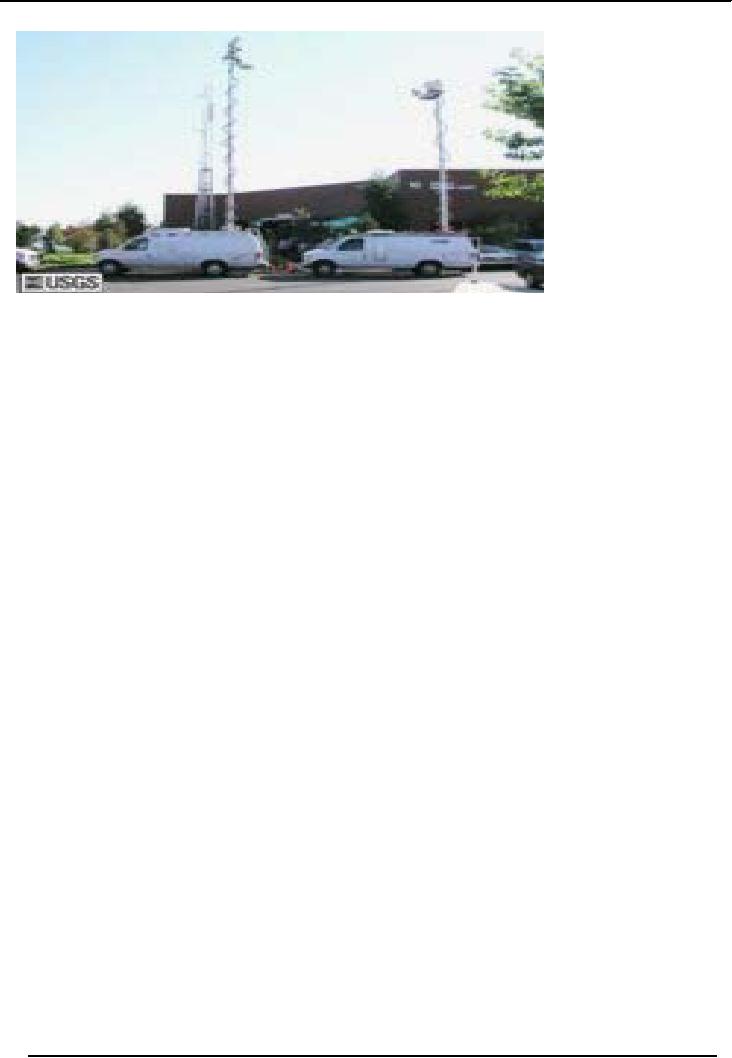 |

TV
News Reporting and Production MCM
516
VU
LESSON
29
ELECTRONIC
FIELD PRODUCTION
Electronic
field production (EFP)
Electronic
field production (EFP) is a television
industry term referring to television
production which
takes
place outside of a formal studio, in a
practical location or special
venue.
Some
typical applications of Electronic
Field Production include
awards
shows,
concerts,
major
newsmaker
interviews, political conventions
and sporting events.
Electronic
field production (EFP) places the
emphasis on high-quality, multi-camera
photography,
advanced
graphics and sound.
Sports
Sports
broadcasts make up the majority of
EFPs. Major broadcast
networks once owned their
own
production
trailers for covering major
events, but since then,
with the explosion in networks on
cable
and
over-the-air, they and broadcast
rental companies rent
production trucks by the day or week
for
more
routine or remote productions.
A
typical sports production
truck includes:
A
large
video switcher,
with an external
digital video effects unit
and
several mix/effect
equipment
allows
the director, flexibility in calling
for certain visual effects in the
broadcast.
Several
tripod-mounted and hand-held
cameras.
A
variety of zoom
lenses for
the tripod-mounted "hard" cameras,
typically at least 50x to
100x
magnification,
and a maximum focal length of at
least 600 mm. The extreme
amount of magnification is
necessary
because the cameras can be located
quite a distance from the
action.
Several
video
recording and
playback
devices
such as VCRs
or
hard
disk recorders.
Certain cameras
or
video feeds can be
"isolated" to specific decks, and
when something happens that
the producer or
director
wants to see again, the deck
can be rewound and shown on the air as an
instant replay. Hard
disk
recorders typically allow
some limited editing
capabilities, allowing highlight
reels to be edited
together
in the middle of a game.
Several
character generators allowing
scores and statistics to be shown on
screen. The scoreboards
used
in
most sports facilities can
be linked to the truck to drive the
television production's graphics as well
as
the
arena scoreboards.
An
audio
mixing booth and a
variety of microphones
to
capture audio from the sportscasters
and from
the
field of play.
Several
miles of various
types of cable.
99

TV
News Reporting and Production MCM
516
VU
Electronic
news gathering
Microwave
trucks seen transmitting. Modern
news employs these trucks
extensively.
ENG
is a broadcasting (usually television)
industry acronym which
stands for Electronic
News
Gathering.
It can mean anything from a
lone reporter taking a
single camcorder or camera
out to get a
story
to an entire television crew taking a
satellite truck on location to do a
live report for a
newscast.
In
its early days, the term
ENG
was
used by newsroom staff to differentiate
between the NG
(newsgathering)
crews that collected TV news
with traditional film
cameras and the new ENG
crews
who
collected TV news with new
electronic analogue tape formats like
low band U-matic.
The
requirement for the differentiation
stems from the radically
different methods of
post-production
involved
in video versus film. Film
needed to be processed before
editing, unlike tape where
footage
could
be edited fairly quickly,
thus dramatically reducing the
turn-around time for a
story. The use of
film
in newsgathering virtually disappeared by
the early 1980s.
ENG
originally referred to the use of
point-to-point terrestrial microwave
signals to backhaul the remote
signal
to the studio. In modern news operations,
however, it also includes
SNG
(Satellite
News
Gathering)
and DSNG
(digital satellite news
gathering).
ENG
is almost always done using a specially
modified truck or van such
as those made by Sat-Comm,
Broadcast
Vehicles, E-N-G, Frontline, and
Wolf coach. Terrestrial
microwave vehicles can
usually be
identified
by their masts which can be
extended up to 50 feet (15 m) in the air
(to allow
line-of-sight
with
the station's receiver antennas), while
satellite trucks always use a
larger dish that unfolds
and
points
skywards towards one of the geostationary communications satellites
operated by companies.
The
acronym ENG was also
used as title for a Canadian
television drama about the
news department of
a
TV station. The series ran
for 96 episodes, from
1989-1994.
100
Table of Contents:
- CREATIVITY AND IDEA GENERATION FOR TELEVISION:Video Procedures
- PRE-REQUISITES OF A CREATIVE PRODUCER/DIRECTOR:SET-UP RESPONSIBILITIES
- REFINING AN IDEA FOR PRODUCTION:Drama, Magazine Shows, Documentary
- CONCEPT DEVELOPMENT:Variable. Pure and applied research
- RESEARCH AND REVIEWS:Research Procedure, Review of available literature
- SCRIPT WRITING:Elements of a successful story, Characters, Effects
- PRE-PRODUCTION PHASE:Indoor production, Outdoor production, Essentials of PBE
- SELECTION OF REQUIRED CONTENT AND TALENT:Camera rehearsal
- PROGRAMME PLANNING:Checklist, Electronic Field Production (EFP)
- PRODUCTION PHASE:Floor plan, Traditional set, Representational set, Design elements
- CAMERA WORK:Movement of lens of camera, Types of shots
- LIGHT AND AUDIO:Importance of sound in TV, Use of microphone, Loudness
- DAY OF RECORDING/PRODUCTION:Rehearsals,Point to ponder
- LINEAR EDITING AND NLE:Episode, Scene, Editing, Production Switcher
- MIXING AND USES OF EFFECTS:Live Sound Effects, ARROW STRIKING
- SELECTION OF THE NEWS:Elements of news, Timeliness, proximity
- WRITING OF THE NEWS:The inverted pyramid, Lead, Credit line
- EDITING OF THE NEWS:Characteristics of good news:Process of editing a news
- COMPILATION OF NEWS BULLETIN:Hard news, Soft news, Investigative report
- PRESENTATION OF NEWS BULLETIN
- MAKING SPECIAL BULLETINS:Agriculture, Show biz, Fashion, Drama
- TECHNICAL CODES, TERMINOLOGY, AND PRODUCTION GRAMMAR
- TYPES OF TV PRODUCTION:Magazine Shows, Specific audience programming
- DRAMA AND DOCUMENTARY:Documentary film, Defining documentary
- SOURCES OF TV NEWS:Reporters, Correspondents, Monitoring, News Agency
- FUNCTIONS OF A REPORTER
- BEATS OF REPORTING:City reporter, Social reporters, Show-biz reporter
- STRUCTURE OF NEWS DEPARTMENT:Beat Reporters, Online media
- ELECTRONIC FIELD PRODUCTION:Sports, Electronic news gathering
- LIVE TRANSMISSIONS:Studio floor, Switcher, Master control room, Camera control units
- QUALITIES OF A NEWS PRODUCER:Determination, Awareness, Sharp an active
- DUTIES OF A NEWS PRODUCER
- ASSIGNMENT/NEWS EDITOR:Accuracy, Fairness and Reliability, Conflict
- SHOOTING A NEWS FILM:The Influence of telecast News
- PREPARATION OF SPECIAL REPORTS:Uncovering Truth, Reportage
- INTERVIEWS, VOX POPS AND PUBLIC OPINIONS:INTERVIEW, Information
- BACK GROUND VOICE AND VOICE OVER:Natural or Raw Sound, Sound Effects
- SPOKEN WORDS AND RELEVANT VISUALS:Digital Audio, Quantizing Error
- TALK SHOWS, FORUMS AND DISCUSSION PROGRAMMES
- FUNCTIONS OF VARIOUS DEPARTMENTS OF A TV SET UP
- PROGRAMMES DEPARTMENT:Program content, Television series by genre
- NEWS AND CURRENT AFFAIRS THE PROGRAMMING & SCHEDULING
- COORDINATION AMONG DIFFERENT DEPARTMENTS OF TELEVISION
- COORDINATION AMONG DIFFERENT DEPARTMENTS OF TELEVISION - 2 SUB-DEPARTMENTS AND SMALL SECTIONS
- COORDINATION AMONG DIFFERENT DEPARTMENTS OF TELEVISION 3